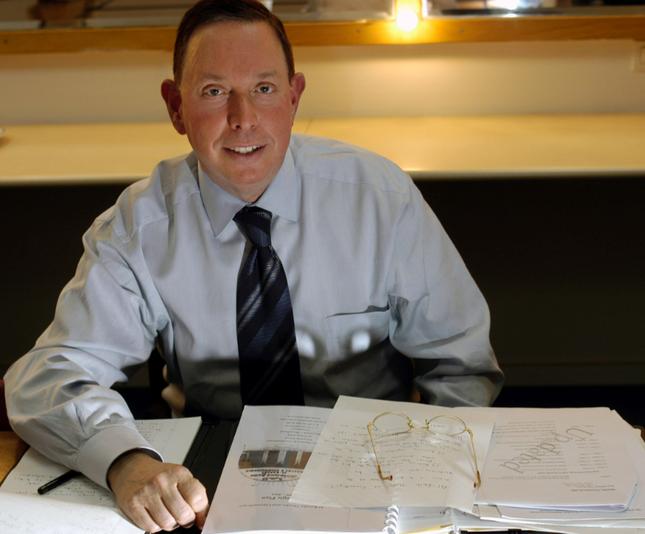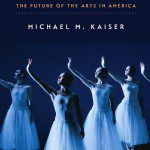Former Kennedy Center Head Sounds Alarm on the Arts in New Book, ‘Curtains?’
By • March 26, 2015 0 1505

I went to see the Washington National Opera company’s production of “The Flying Dutchman” at the Opera House recently. The joint was jumping. A fashion exhibition lined the entrance, glittering with blue, part of the Kennedy Center’s Iberian Festival of Spanish and Portuguese art, as was a live performance at the Millennium Stage.
Part of me was thrilled by the crowds, not only for the opera, but also the exhibitions and performance for the center’s yearly arts festival focusing on a nation or region, which were part of former Kennedy Center President Michael M. Kaiser’s tenure.
A part of me was also a little anxious. I had just finished reading “Curtains? The Future of the Arts in America,” Kaiser’s latest book, a cautionary tome and vision of a troubled, struggling American arts world now and 20 years hence.
Kaiser, now the director of the DeVos Institute of Arts Management at the University of Maryland since last year, posits the problems now facing the American arts community, envisions that world 20 years from now and offers some solutions, one of which is for arts leaders to acknowledge and embrace the new technology, which is, for all intents and purpose, both the new delivery system for art and a road to new, more intimate venues.
“I don’t mean to make anybody depressed,” Kaiser said in a telephone interview with the Georgetowner. “I’m not suggesting that there will be no more art. I am suggesting that the arts—performance art institutions and venues, as well as museums—will be very different, as will audiences. You and I, and people of a certain age and generation, we’re used to consuming art in a certain way. You plan, for instance, to go to an opera at a certain time, on a certain night. You get dressed for the occasion, same as you do for a play, a dance performance, a symphony orchestra concert or a jazz concert.”
“But the newer generations don’t necessarily do things that way,” he continued. “They don’t prefer to do things that way. I travel all over the country, and I spend a lot of time in airports and I see how many people in airports are on their phones or tablets, often watching a show, a movie, listening to music.”
Kaiser has seen that many arts organizations are already heading toward using the new technology to build and grow audiences. “It’s expensive, too expensive, to go to the opera, to concerts, and the theater,” he said. “More and more opera performances, for instance, are now being screened in movie theaters .”
Critics and arts writers—myself among them—often tout the fact that a play, a concert and an opera, are authentic experiences of engagement with an audience, impossible to replicate on a screen. Kaiser probably agrees with that, but he also suggests that new audiences don’t really care how they view or engage performance art or the visual arts, for that matter. While art enthusiasts can debate authenticity all they want, the truth of the matter is that exhibitions, plays, operas, dance, music and the like can be experienced in different ways, more fragmented, and less expensively.
“Companies, producers and managers, in the past, faced with economic constraints and trouble, have tended to think they have two choices—raise prices or cut back on spending and resources, and produce tried-and-true popular projects that are popular with audiences,” Kaiser said.
In terms of content, Kaiser, who has warned about the high cost of tickets before, also insists that producers and managers need to raises their sights and be more adventurous. “You don’t get new audiences with old works and hope that it works,” he said. “Performance arts companies need to do new work to be viable and vital. They need to take risks, engage with the world, challenge the audience. That’s what will bring in new audiences.”
But it won’t be easy. The odds, he suggests, are daunting, for several reasons.
“The generations now coming into their own, into theater-going age and capability, are woefully under educated in the arts,” Kaiser said. “The emphasis on arts and culture in our public and private school system has declined dramatically. They come to the cultural marketplace absent a body of knowledge and desire.”
The decline of media outlets—and especially newspapers of old, which usually featured knowledgeable, professional and opinionated arts critics—is also a critical factor in the worrisome decline and problem of the arts in America, according to Kaiser.
Also a factor is the erosion of a long-term donor class. “That generation of donors whom you could count on is dying out and donors have to be found from a new generation,” he said. “This generation, it’s been said, is more interested in politics or causes. And if they get involved, they won’t do it at the level the arts are used to having from donors.”
Kaiser is concerned, not so much about large institutions like the Kennedy Center or the Metropolitan Opera, (although major opera companies and orchestras face the additional problem of labor costs and have been plagued by strikes), but about mid-level groups and institutions which are struggling to adapt and compete. “I think you’ll find that large institutions will engage with, adapt to and use the new technology,” he said. “It’s already happening, with screenings and streaming of live performances. But smaller groups might not be able to compete.”
Kaiser’s thin book is pragmatic, structured and thick with facts, ideas and anecdotes, including telling and knowing observations about technology—and oddly, sports, where he finds similarities.
“Think about what happens, how sports have grown into this kind of eco-system that embraces delivery, technology and changing attitudes in the fans,” he said. “This may happen to the arts to—what if we have an audience that doesn’t want to hear an entire symphony or opera, but just the highlights,” he said. “This is what happens in football and sports now.”
Much of what Kaiser talks about in his book—and I couldn’t recommend it more to anyone interested in the arts, in plays, in music, in live performances—seems already on the horizons. You see and hear more and more operas in English, there’s Opera in the Outfield, a screening of a WNO Opera at Nationals Park, an emphasis on new and shorter work, the cross-pollenization of genres, the uses of add-ons in theater. Many theaters now add interactive aspects to plays—post-play discussions, quizzes, trivia games in the lobby and so on.
These days, Kaiser travels extensively. He still lives in Washington and is proud of his tenure at the Kennedy Center. “I certainly miss the people I worked with there,” he said. He writes a blog for the Huffington Post on topics that range across the whole spectrum of the arts.
From the bird’s eye view of Washington, where the arts seem, with some notable exceptions, for the most part to be flourishing, Kaiser’s book is a warning about a rapidly and dramatically changing arts world .
There may come a time when “Dutchman” and Iberian nights — or the time in 2007 when Kaiser and Michael Kahn, the artistic director of the Shakespeare Theatre Company, pulled together people and places of the D.C. arts community into a six-month “Shakespeare in Washington’ Festival — will be a fond memory.
Kaiser, who steered the Alvin Ailey Dance Company, the Royal Opera House and the American Ballet Theatre as well as the Kennedy Center, is more optimistic and pragmatic than nostalgic by nature. “I’m not predicting the end of the arts, “ he said.
- Michael Kaiser, former head of the Kennedy Center for the Performing Arts.



